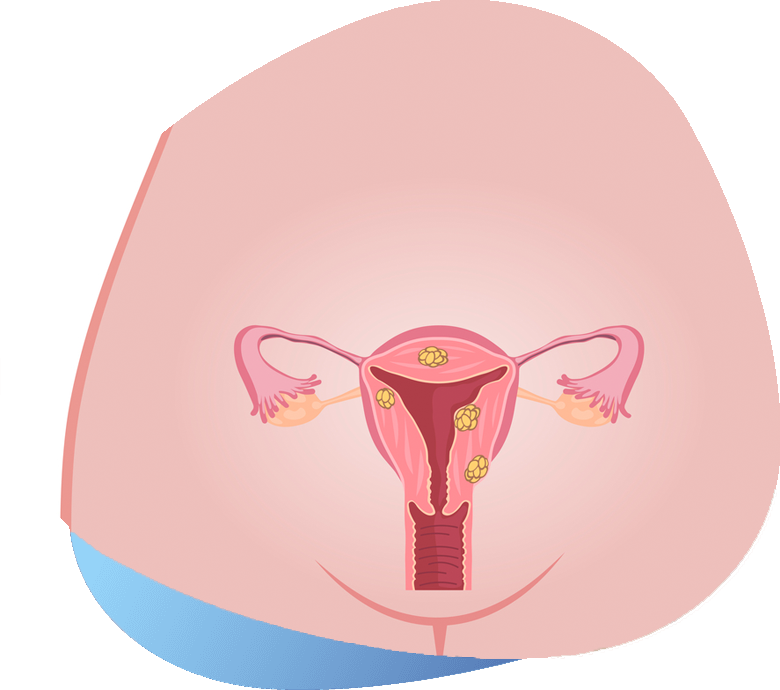Uterine Fibroids Doctor in Wakad
Uterine fibroids are benign growths in the uterus that typically manifest during a woman's childbearing years. Commonly referred to as leiomyomas (lie-o-my-O-muhs) or myomas. These non-cancerous tumors can often go unnoticed for extended periods. Dr. Poonam Patole, a medical professional specializing in Obstetrics and Gynaecology, notes that while not all fibroids exhibit symptoms, those that do may result in heavy menstrual bleeding, frequent urination, and pain during sexual intercourse. Treatment for fibroids varies, with small fibroids often requiring no intervention, while larger ones may necessitate medication or surgery.

uterine fibroids
Overview
Dr. Poonam Patole, a leading gynecologist-obstetrician in Wakad, Pune, specializes in uterine fibroids, noncancerous growths prevalent during childbearing years. With expertise spanning routine pelvic exams and prenatal care, Dr. Patole diagnoses fibroids, emphasizing their noncancerous nature.
These growths, ranging from tiny to substantial masses, may cause symptoms like heavy bleeding and pelvic pain. Dr. Patole encourages women, especially those at higher risk, to stay vigilant for symptoms and seek timely medical attention.
Her patient-centered approach focuses on personalized care, ensuring comprehensive reproductive health management for women under her expert guidance. Regular check-ups are pivotal for monitoring potential complications.
Symptoms of Uterine Fibroids
Symptoms vary among women with fibroids, and many may not experience any noticeable signs. However, for those who do, the nature and intensity of symptoms are influenced by factors such as the location, size, and quantity of fibroids. Common signs and symptoms of uterine fibroids in women who experience them include:
- Heavy menstrual bleeding
- Menstrual periods that extend beyond a week
- Pelvic pressure or pain
- Frequent urination
- Difficulty emptying the bladder
- Constipation
- Backache or leg pains
Rarely, a fibroid can cause acute pain when it outgrows its blood supply, and begins to die. Fibroids are generally classified by their location. Intramural fibroids grow within the muscular uterine wall. Submucosal fibroids bulge into the uterine cavity. Subserosal fibroids project to the outside of the uterus.
When to Consult a Doctor
Make an appointment with your doctor if you experience:- Persistent pelvic pain
- Excessively heavy, prolonged, or painful periods
- Spotting or bleeding between periods
- Difficulty emptying your bladder
- Unexplained low red blood cell count (anemia)
Causes of Uterine Fibroids
The exact cause of uterine fibroids remains unknown, but research and clinical experience suggest the following factors:- 1. Genetic changes: Many fibroids exhibit alterations in genes that differ from those in typical uterine muscle cells.
- 2. Hormones: Estrogen and progesterone, hormones that stimulate the development of the uterine lining in preparation for pregnancy during each menstrual cycle, seem to contribute to fibroid growth. Fibroids contain more estrogen and progesterone receptors than typical uterine muscle cells. Fibroids generally shrink after menopause due to decreased hormone production.
- 3. Other growth factors: Substances aiding the body in maintaining tissues, such as insulin-like growth factor, may influence fibroid growth.
- 4. Extracellular matrix (ECM): ECM is the material that binds cells together, akin to mortar between bricks. Fibroids have an increased amount of ECM, making them fibrous. ECM also stores growth factors and induces biological changes in the cells.
Risk factors of uterine fibroids
There are a few identified risk factors for uterine fibroids, particularly for women of reproductive age. These factors influencing the development of fibroids include:- Race. While fibroids can develop in women of any race during their reproductive years, black women are more prone to having fibroids than women of other racial groups. Moreover, black women tend to develop fibroids at younger ages, and they are more likely to experience larger fibroids with more severe symptoms.
- Heredity. If your mother or sister has had fibroids, your risk of developing them increases. There appears to be a familial predisposition to fibroid development.
- Other factors. Several lifestyle and health factors can contribute to an increased risk of fibroids. .These include: .Early onset of menstruation .Obesity .Vitamin D deficiency .A diet that is higher in red meat and lower in green vegetables, fruits, and dairy .Consumption of alcohol, including beer These factors may play a role in the development of uterine fibroids, emphasizing the importance of understanding and managing risk factors to promote women's reproductive health. Regular check-ups with healthcare providers can aid in monitoring and addressing potential risks associated with uterine fibroids.
Complications
While uterine fibroids are generally not considered dangerous, they can bring about discomfort and may result in complications, such as a decrease in red blood cells (anemia) due to heavy blood loss, leading to fatigue. In rare cases, blood loss might be severe enough to necessitate a transfusion.Pregnancy and fibroids Regarding pregnancy and fibroids, these growths typically don't impede the ability to conceive. However, there is a possibility that fibroids, particularly submucosal ones, could contribute to infertility or pregnancy loss. Fibroids might also elevate the risk of specific pregnancy complications, including placental abruption, fetal growth restriction, and preterm delivery.
